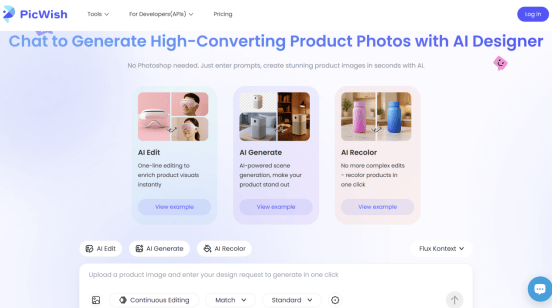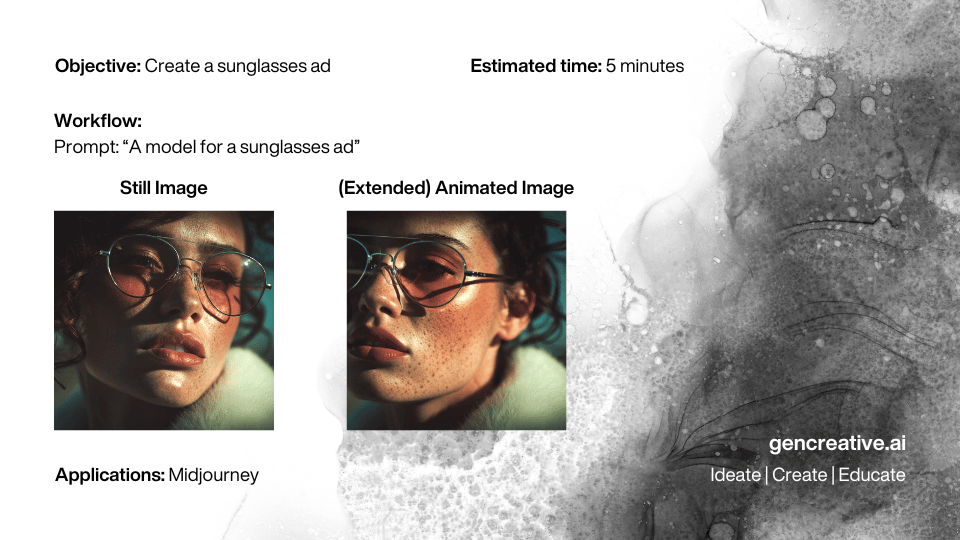- The Gen Creative
- Posts
- PicWish Unveils AI Designer for Text‐Based Photo Editing
PicWish Unveils AI Designer for Text‐Based Photo Editing
+ Innovid’s AI Tools Automate and Optimize Ad Creation
The Gen Creative
Today’s Creative Spark…
PicWish Unveils AI Designer for Text‑Based Photo Editing
Innovid’s AI Tools Automate and Optimize Ad Creation
AI Art Passes the Aesthetic Turing Test
Students Design Digital Lockers with Canva and AI
Generative Design: AI Reshapes Product Development
If AI can now edit photos, design ads, pass as an artist, teach kids to create, and invent new products—are we still shaping the tools, or are the tools starting to shape us?
Read time: 8 minutes
Photo Editing

Source: Financial Content
Summary: PicWish introduced AI Designer, a tool that turns natural‑language prompts into sophisticated photo edits. Users can write commands like “replace background with tropical beach” or “change hairstyle to curly,” and the system re‑composes the image accordingly. Additional modes allow cartoon‑style conversions, product color variations, vintage photo restoration and even virtual fashion try‑ons. The platform leverages multiple models—including Gemini 2.0, GPT Image‑1 and Flux Kontext to maintain subject realism while applying drastic transformations. With text‑driven editing, marketers, e‑commerce sellers and social‑media creators can rapidly iterate visuals without manual Photoshop skills.The tool demonstrates how AI can democratize high‑quality image design, empowering both professionals and hobbyists to reimagine their photos.
Five Essential Elements:
Natural‑Language Editing: AI Designer interprets typed descriptions to perform complex edits—background changes, hairstyle swaps and style conversions.
Diverse Creative Modes: Users can generate cartoons, alter product colors, repair vintage photos and apply virtual fashion try‑ons within the same platform.
Advanced Model Integration: The system combines models like Gemini 2.0 and GPT Image‑1 to preserve subject integrity while applying transformative effects.
Workflow Efficiency: Designers and marketers can test multiple visual concepts quickly, reducing reliance on expensive software and specialized skills.
Democratized Design: By lowering technical barriers, AI Designer enables anyone to create professional‑quality images for campaigns, portfolios or personal projects.
Published: August 25, 2025
Ad Creation

Source: businesswire
Summary: Advertising technology firm Innovid released a suite of AI‑powered tools designed to streamline creative workflows for marketers. Auto Classification uses image recognition and natural language processing to tag and categorize creative assets automatically, simplifying asset management. Smart Framing adapts backgrounds and aspect ratios to fit multiple ad formats without manual cropping or design adjustments. Auto Optimization employs neural‑network decisioning to serve the best‑performing creative in real time, based on audience engagement metrics. Finally, Version Generation produces new copy, imagery and even voiceovers via text‑to‑speech from a simple prompt. Together, these features free up creative teams to focus on storytelling while ensuring campaigns are optimized for each audience.
Four Essential Elements:
Automatic Asset Labeling: Auto Classification organizes visuals by theme, product or audience using AI, reducing manual labor.
Smart Background Fitting: Smart Framing automatically scales and positions creative assets across different ad sizes and platforms.
Real‑Time Optimization: Neural networks analyze performance and dynamically select the highest‑impact creative variations.
Prompt‑Based Versioning: Marketers can generate fresh copy, images and voiceovers with a single prompt, accelerating multivariate testing.
Published: August 25, 2025
Workflow by The Gen Creative

In each newsletter, the Gen Creative team puts together a practical creative workflow so you can get ideas of how to implement AI right away. Want to see more? Check them out here!
Humans & AI

Source: Complete AI Training
Summary: An emerging milestone in creative AI shows that machine‑generated art has become indistinguishable from human creations. Researchers tested audiences by mixing famous artists’ works with AI‑generated pieces; many participants couldn’t tell the difference. Real‑world examples, such as a Vogue advertisement featuring an AI model that fooled viewers, illustrate the technology’s sophistication. This breakthrough raises ethical questions about authorship, value and the emotional authenticity of art. Experts argue that instead of replacing artists, AI should serve as a collaborator, combining machine precision with human intuition. As algorithms advance, hybrid approaches and clear guidelines will be essential to preserve artistic integrity.
Five Essential Elements:
Aesthetic Turing Test: AI art now passes a test where humans cannot reliably distinguish machine‑made works from human ones.
Experimental Evidence: Studies show participants struggled to identify AI pieces among works by Gauguin, Basquiat and others.
Real‑World Examples: Commercial campaigns have used AI‑generated models that fooled even experts.
Ethical Questions: Debates center on authenticity, authorship and the value of machine‑produced art.
Human‑AI Collaboration: Creatives see AI as a tool to augment rather than replace human imagination, highlighting the need for ethical standards.
Published: August 25, 2025
Design by Students

Source: The Cullman Tribune
Summary: At East Elementary School in Cullman, Alabama, fifth‑ and sixth‑grade students built their own “digital lockers” using Canva’s design software and its Magic Media AI tool. Students first completed a survey to identify their interests and personalities, then decorated their lockers with images, clip art and text reflecting their favorite books and hobbies. They also used an AI avatar generator to create animated portraits of themselves, introducing them to generative art in a playful context. Library media specialist Savannah Wood said the project exposes children to AI without tying it to a specific subject, helping them develop information‑gathering and creative‑thinking skills. The initiative demonstrates how design tools can engage young learners, blending personalization, creativity and technology in the classroom.
Five Essential Elements:
Project Overview: Students created personalized digital lockers using Canva and AI, combining design and self‑expression.
Interest‑Driven Decor: Surveys helped students choose images, clip art and text that reflect their personalities and favorite books.
AI Avatar Creation: The Magic Media tool generated custom avatars, introducing generative art to children.
Educational Benefits: The project fosters information‑gathering skills and encourages imaginative thinking in a non‑subject‑specific context.
Model for Creative Learning: Digital lockers illustrate how AI‑enabled design tools can make learning engaging and personalized.
Published: August 24, 2025
Product Development

Source: Complete AI Training
Summary: Generative design leverages algorithms to explore thousands of design options within defined parameters, producing parts that are lighter, stronger and more efficient than those conceived through traditional methods. Instead of refining a single idea, designers input constraints such as materials, weight and cost and the software generates multiple geometries that meet those conditions. This technique pairs well with 3D printing, enabling complex structures that conventional manufacturing cannot achieve. Industries from architecture and automotive to aerospace and consumer goods already apply generative design to optimize performance and reduce waste. Top platforms like Autodesk’s Fusion 360, Dassault Systèmes’ CATIA, Siemens’ NX, nTop and PTC’s Creo offer integrated generative design capabilities. While challenges remain—such as evaluating numerous options and integrating AI into existing workflows—the approach is transforming how products are conceived.
Five Essential Elements:
Exploring Massive Design Spaces: AI evaluates thousands of possibilities within constraints to find optimal designs.
Constraint‑Driven Workflow: Designers set material, weight and cost parameters; algorithms then generate compliant geometries.
3D‑Printing Synergy: Generative design often produces intricate forms best realized through additive manufacturing.
Cross‑Industry Adoption: Architecture, automotive, aerospace and consumer products use the approach to improve performance and sustainability.
Leading Platforms: Fusion 360, CATIA, NX, nTop and Creo integrate generative design into professional toolchains.
Published: August 23, 2025
Remote Creative Jobs
5 Remote Startup Creative Jobs
Graphic Designer: Kalshi, the first U.S.-legal prediction market, seeks a Graphic Designer to deliver fast, high-impact visuals for sports, politics, and culture.
Product Designer: Thumbtack is hiring a Senior Product Designer to craft intuitive, impactful experiences that help millions of homeowners manage projects, from urgent repairs to big improvements.
Motion Designer: Fay is seeking a Motion Designer to craft engaging animations that make health journeys feel rewarding, bringing motion design to life across app, web, and marketing to inspire healthier habits.
Director, Brand & Creative: Blink Health seeks a Brand & Creative Director to build and scale BlinkRx’s brand, driving narrative, creative, and category leadership.
Video Editor: IMPACT BRANDS is hiring a Remote Video Editor to create impactful, conversion-driven videos for our global wellness brands — with full remote flexibility, growth opportunities, and great perks.
See you next time!
Creativity moves between big ideas and small details. 🎨🎵 AI is beginning to handle some of those details—adjusting an image, evening out audio, refining words. 🖼️🎚️✍️ It works quietly, leaving more room for the ideas. 📸🎧📄
How did you like it?
We'd love to hear your thoughts on today’s Creative Spark! ✨ Your feedback helps us improve and tailor future newsletters to your interests. 📝 Please take a moment to share your thoughts and let us know what you enjoyed or what we can do better. 💬 Thank you for being a valued reader! 🌟
Keep Reading
A new wave of AI poster makers is empowering non‑designers to produce polished visuals at speed. Platforms like Canva’s Magic Design recommend layouts and color schemes based on a user’s theme, while one‑click resizing adapts posters for social platforms without manual adjustments. AI can suggest on‑brand images, typography and even short copy, making it easier to generate cohesive marketing materials. These tools drastically cut costs compared with hiring professional designers, and they offer drag‑and‑drop customization so teams can personalize templates. By automating layout and visual decisions, AI poster makers allow marketers, event organizers and educators to produce print‑ready designs in minutes The result is a democratized design landscape where creativity is limited only by imagination, not software expertise.
Banani’s review of AI prototyping tools highlights how generative interfaces are reshaping product design workflows. Banani itself generates multiple high‑fidelity screens from a text description, allows edits through AI chat and exports directly to Figma. MagicPatterns produces wireframes aligned with a team’s existing design system, ensuring that prototypes remain consistent with production code. V0.app outputs clean React components and supports complex logic, making prototypes immediately useful for developers. Lovable builds full‑stack MVPs—including frontend, backend and authentication—in minutes, ideal for founders testing ideas quickly. Relume accelerates landing‑page design, giving marketers and product managers interactive site prototypes without extensive coding. Together, these tools enable product managers, designers and developers to iterate rapidly and bring ideas to market faster.
A new paradigm of design partners is emerging, where AI tools act as collaborators throughout the design process.These agents can rapidly iterate on ideas using large datasets, recommending improvements and speeding product development. Real‑world collaborations, such as a Chilean salmon industry partnership with MIT to develop eco‑friendly packaging, show how human‑AI teams tackle complex challenges. Reports from Autodesk and McKinsey highlight the growing importance of cloud‑based collaboration and AI‑ready data in design workflows. However, integrating AI raises concerns about data privacy, ethics and talent gaps, underscoring the need for training and responsible use. Experts predict that by 2025, AI design partners will become essential, blending human creativity with machine precision across industries.